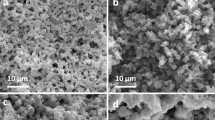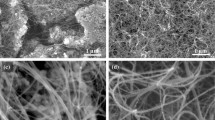Abstract
Binary NiCo alloy/carbon composite monoliths with well-defined macropores and mesostructured skeletons have been facilely fabricated by a solgel process followed by heat treatment at Ar atmosphere, and the morphology control, heat treatment and pore structures of the composite monoliths were investigated in detail. Synergic control of phase separation and solgel transition allows the formation of three-dimensional nickel–cobalt hydroxide-based xerogel monoliths with interconnected macropores and co-continuous solid skeletons. Heat treatment at 270–340 °C promotes the precipitation of nickel–cobalt oxides and the pyrolysis of PAA into carbon, and at and above 400 °C, some in situ formed carbon can carbothermally reduce nickel–cobalt oxides to generate the NiCo alloy and form NiCo alloy/carbon composites, without any deterioration of the macrostructure of monoliths. The as-prepared NiCo alloy/carbon composite monolith possesses hierarchical pore structure with a macropore size of 0.5 μm, a mesopore size of 2 nm, a specific surface area up to 167 m2 g−1 and a porosity as high as 80%. This three-dimensional hierarchically porous binary NiCo alloy/carbon monoliths are promisingly used in wide applications such as catalysis, filtration, separation, sensor.











Similar content being viewed by others
References
Dheeraj PR, Patra A, Sengupta S, Das S, Das K (2017) Synergistic effect of peak current density and nature of surfactant on microstructure, mechanical and electrochemical properties of pulsed electrodeposited Ni–Co–SiC nanocomposites. J Alloys Compd 729:1093–1107
Hu P, Chen ZY, Chang T, Deng J, Yang F, Wang KS, Li QW, Hu BL, Yu HL, Wang WP (2017) Magnetic properties of the nanoscale coral-shaped Ni–Co alloy powder with different Co contents. J Alloys Compd 727:332–337
Gao Y, Luo B, He K, Zhang W, Bai Z (2018) Effect of Fe/Ni ratio on the microstructure and properties of WC–Fe–Ni–Co cemented carbides. Ceram Int 44:2030–2041
Yousuf S, Gupta DC (2017) Investigation of electronic, magnetic and thermoelectric properties of Zr2NiZ (Z=Al, Ga) ferromagnets. Mater Chem Phys 192:33–40
Sao-Joao S, Giorgio S, Penisson JM, Chapon C, Bourgeois S, Henry C (2005) Structure and deformations of Pd–Ni core–shell nanoparticles. J Phys Chem B 109:342–347
Xiao Q, Sarina S, Bo A, Jia J, Liu H, Arnold DP, Huang Y, Wu H, Zhu H (2014) Visible light-driven cross-coupling reactions at lower temperatures using a photocatalyst of palladium and gold alloy nanoparticles. ACS Catal 4:1725–1734
Molenbroek AM, Nørskov JK, Clausen BS (2001) Structure and reactivity of Ni–Au nanoparticle catalysts. J Phys Chem B 105:5450–5458
Wang L, Yamauchi Y (2011) Strategic synthesis of trimetallic Au@Pd@Pt core–shell nanoparticles from poly(vinylpyrrolidone)-based aqueous solution toward highly active electrocatalysts. Chem Mater 23:2457–2465
Anandan S, Grieser F, Ashokkumar M (2008) Sonochemical synthesis of Au–Ag core–shell bimetallic nanoparticles. J Phys Chem C 112:15102–15105
Thomas JM, Raja R, Johnson B, Hermans S, Jones MD, Khimyak T (2003) Bimetallic catalysts and their relevance to the hydrogen economy. Ind Eng Chem Res 42:1563–1570
Doudna CM, Bertino MF, Blum FD, Tokuhiro AT, Lahiri-Dey D, Chattopadhyay S, Terry J (2003) Radiolytic synthesis of bimetallic Ag–Pt nanoparticles with a high aspect ratio. J Phys Chem B 107:2966–2970
Belloni J, Mostafavi M, Remita H, Marignier JL, Delcourt MO (1998) Radiation-induced synthesis of mono- and multi-metallic clusters and nanocolloids. New J Chem 22:1239–1255
Mizukoshi Y, Okitsu K, Maeda Y, Yamamoto TA, Oshima R, Nagata Y (1997) Sonochemical preparation of bimetallic nanoparticles of gold/palladium in aqueous solution. J Phys Chem B 101:7033–7037
Robinson I, Zacchini S, Tung LD, Maenosono S, Thanh NTK (2009) Synthesis and characterization of magnetic nanoalloys from bimetallic carbonyl clusters. Chem Mater 21:3021–3026
Li CL, Tan HB, Lin JJ, Luo XL, Wang SP, You J, Kang Y, Bando Y, Yamauchi Y, Kim J (2018) Emerging Pt-based electrocatalysts with highly open nanoarchitectures for boosting oxygen reduction reaction. Nano Today 21:91–105
Yin Z, Zhou W, Gao Y, Ma D, Kiely CJ, Bao X (2012) Supported Pd–Cu bimetallic nanoparticles that have high activity for the electrochemical oxidation of methanol. Chem Eur J 18:4887–4893
Brayner R, Coradin T, Fievet-Vincent F, Livage J, Fievet F (2005) Algal polysaccharide capsule-templated growth of magnetic nanoparticles. New J Chem 29:681–685
Zubris M, King RB, Garmestani H, Tannenbaum R (2005) FeCo nanoalloy formation by decomposition of their carbonyl precursors. J Mater Chem 15:1277–1285
Ataee-Esfahani H, Wang L, Nemoto Y, Yamauchi Y (2010) Synthesis of bimetallic Au@Pt nanoparticles with Au core and nanostructured Pt shell toward highly active electrocatalysts. Chem Mater 22:6310–6318
Bae S, Kim J, Randriamahazaka H, Moon S, Park J, Oh I (2017) Seamlessly conductive 3D nanoarchitecture of core–shell Ni–Co nanowire network for highly efficient oxygen evolution. Adv Energy Mater 7:1601492–1601502
Pérez-Alonso FJ, Adán C, Rojas S, Peña MA, Fierro JLG (2015) Ni–Co electrodes prepared by electroless-plating deposition. A study of their electrocatalytic activity for the hydrogen and oxygen evolution reactions. Int J Hydrog Energy 40:51–61
Atkinson A, Barnett S, Gorte RJ, Irvine J, Mcevoy AJ, Mogensen M, Singhal SC, Vohs J (2004) Advanced anodes for high-temperature fuel cells. Nat Mater 3:17–27
Zhang L, Bain JA, Zhu HG, Abelmann L, Onoue T (2006) Characterization of heat-assisted magnetic probe recording on CoNi/Pt multilayers. J Magn Magn Mater 305:16–23
Chen B, Chen D, Kang Z, Zhang Y (2015) Preparation and microwave absorption properties of Ni–Co nanoferrites. J Alloys Compd 618:222–226
Huang XH, Dai B, Ren Y, Xu J, Zhu P (2015) Preparation and study of electromagnetic interference shielding materials comprised of Ni–Co coated on web-like biocarbon nanofibers via electroless deposition. J Nanomater 2015:1–7
Gao Y, Huang L, Zheng ZJ, Li H, Zhu M (2007) The influence of cobalt on the corrosion resistance and electromagnetic shielding of electroless Ni–Co–P deposits on Al substrate. Appl Surf Sci 253:9470–9475
Ghahremaninezhad A, Dolati A (2009) A study on electrochemical growth behavior of the Co–Ni alloy nanowires in anodic aluminum oxide template. J Alloys Compd 480:275–278
Liu Q, Guo X, Wang T, Li Y, Shen W (2010) Synthesis of CoNi nanowires by heterogeneous nucleation in polyol. Mater Lett 64:1271–1274
Garcia C, Lecante P, Warot-Fonrose B, Neumeyer D, Verelst M (2008) Electrochemical synthesis of cobalt nickel nanowires in an ethanol–water bath. Mater Lett 62:2106–2109
Zhang DE, Ni XM, Zhang XJ, Zheng HG (2006) Synthesis and characterization of Ni–Co needle-like alloys in water-in-oil microemulsion. J Magn Magn Mater 302:290–293
Shen X, Cao K, Zhou J (2006) Preparation of ferromagnetic binary alloy fine fibers by organic gel-thermal reduction process. Trans Nonferrous Met Soc 16:1003–1008
Xie W, Cheng HF, Chu ZY, Chen ZH (2008) Development on preparation of magnetic metallic fiber absorber. J Mater Eng 03:72–76 (Chinese)
Jiang X, Li H, Li S, Huang S, Zhu C, Hou L (2018) Metal–organic framework-derived Ni–Co alloy@carbon microspheres as high-performance counter electrode catalysts for dye-sensitized solar cells. Chem Eng J 334:419–431
Xie Z, Cui X, Xu W, Wang Y (2017) Metal–organic framework derived CoNi@CNTs embedded carbon nanocages for efficient dye-sensitized solar cells. Electrochim Acta 229:361–370
Sun T, Cao J, Dong J, Du H, Zhang H, Chen J, Xu L (2017) Ordered mesoporous Ni Co alloys for highly efficient electrocatalytic hydrogen evolution reaction. Int J Hydrog Energy 42:6637–6645
Minakuchi H, Nakanishi K, Soga N, Ishizuka N, Tanaka N (1996) Octadecylsilylated porous silica rods as separation media for reversed-phase liquid chromatography. Anal Chem 68:3498–3501
Sun TT, Dong J, Huang Y, Ran W, Chen JF, Xu LB (2018) Highly active and stable electrocatalyst of Ni2P nanoparticles supported on 3D ordered macro-/mesoporous Co–N-doped carbon for acidic hydrogen evolution reaction. J Mater Chem A 6:12751–12758
Sun TT, Shan NN, Xu LB, Wang JX, Chen JF, Zakhidov AA, Baughman RH (2018) General synthesis of 3D ordered macro-/mesoporous materials by templating mesoporous silica confined in opals. Chem Mater 30:1617–1624
Li C, Iqbal M, Lin JJ, Luo XL, Jiang B, Malgras V, Wu KCW, Kim J, Yamauchi Y (2018) Electrochemical deposition: an advanced approach for templated synthesis of nanoporous metal architectures. Acc Chem Res 51:1764–1773
Feng DY, Lin Z, Liu MM, Xie J, Wan JM, Wang B, Zhou Y, Yang HL, Zheng HL, Peng ZQ, Hu ZW (2016) Silica–alumina gel humidity control beads with bimodal pore structure produced by phase separation during the sol–gel process. J Microporous Mesoporous Mater 222:138–144
Gash AE, Tillotson TM, Satcher JH, Poco JF, Hrubesh LW, Simpson RL (2001) Use of epoxides in the sol–gel synthesis of porous iron(III) oxide monoliths from Fe(III) salts. Chem Mater 13:999–1007
Guo X, Li W, Nakanishi K, Kanamori K, Zhu Y, Yang H (2013) Preparation of mullite monoliths with well-defined macropores and mesostructured skeletons via the sol–gel process accompanied by phase separation. J Eur Ceram Soc 33:1967–1974
Guo X, Nakanishi K, Kanamori K, Zhu Y, Yang H (2014) Preparation of macroporous cordierite monoliths via the sol–gel process accompanied by phase separation. J Eur Ceram Soc 34:817–823
Nakanishi K, Tanaka N (2007) Sol–gel with phase separation. Hierarchically porous materials optimized for high-performance liquid chromatography separations. Acc Chem Res 40:863–873
Nakanishi K, Soga N (1992) Phase-separation in silica sol–gel system containing polyacrylic-acid. 1. Gel formation behavior and effect of solvent composition. J Non-cryst Solids 139:1–13
Arndt KF, Richter A, Ludwig S, Zimmermann J, Kressler J, Kuckling D, Adler HJ (1999) Poly(vinyl alcohol)/poly(acrylic acid) hydrogels: FT-IR spectroscopic characterization of crosslinking reaction and work at transition point. Acta Polym 50:383–390
Deniau G, Azoulay L, Bougerolles L, Palacin S (2006) Surface electroinitiated emulsion polymerization: grafted organic coatings from aqueous solutions. Chem Mater 18:5421–5428
Bisetty K, Govender P, Kruger HG (2006) Analysis of the conformational profile of trishomocubane amino acid dipeptide. Biopolymers 81:339–349
Hu Y, Jiang XQ, Ding Y, Ge HX, Yuan YY, Yang CZ (2002) Synthesis and characterization of chitosan–poly(acrylic acid) nanoparticles. Biomaterials 23:3193–3201
Kido Y, Nakanishi K, Miyasaka A, Kanamori K (2012) Synthesis of monolithic hierarchically porous iron-based xerogels from iron(III) salts via an epoxide-mediated sol–gel process. Chem Mater 24:2071–2077
Kido Y, Nakanishi K, Okumura N, Kanamori K (2013) Hierarchically porous nickel/carbon composite monoliths prepared by sol–gel method from an ionic precursor. Microporous Mesoporous Mater 176:64–70
Kido Y, Nakanishi K, Kanamori K (2013) Sol–gel synthesis of zinc ferrite-based xerogel monoliths with well-defined macropores. RSC Adv 3:3661–3666
Gash AE, Satcher JH, Simpson RL (2004) Monolithic nickel(II)-based aerogels using an organic epoxide: the importance of the counterion. J Non-Cryst Solids 350:145–151
Herber I, Tang W, Wong H, Lam T, Siu C, Beyer MK (2015) Reactivity of hydrated monovalent first row transition metal ions [M(H2O)n]+, M=Cr, Mn, Fe Co, Ni, Cu, and Zn, n < 50, toward acetonitrile. J Phys Chem A 119:5566–5578
Yang XH, Yin CS (2004) Study on hydrolysis constants pK1 of metal ions by using artificial neural network. Chin J Inorg Chem 20:1334–1338 (Chinese)
Liu GC (2002) Relation between metal ion hydrolysis constant and valence electron average binding energy. J Haerbin Univ 23:40–41 (Chinese)
Motlak M, Barakat NAM, Akhtar MS, Hamza AM, Kim B, Kim CS, Khalil KA, Almajid AA (2015) High performance of NiCo nanoparticles-doped carbon nanofibers as counter electrode for dye-sensitized solar cells. Electrochim Acta 160:1–6
Acknowledgements
This work was supported by the High Science and Technique Brainstorm Project of Zhejiang Province of China (No. 2017C01002) and the National Natural Science Foundation of China (21875217 and 51372225).
Author information
Authors and Affiliations
Corresponding author
Rights and permissions
About this article
Cite this article
Feng, D., Yang, H., Wang, Q. et al. Preparation and characteristic of three-dimensional NiCo alloy/carbon composite monoliths with well-defined macropores and mesostructured skeletons. J Mater Sci 54, 4719–4731 (2019). https://doi.org/10.1007/s10853-018-03224-7
Received:
Accepted:
Published:
Issue Date:
DOI: https://doi.org/10.1007/s10853-018-03224-7




